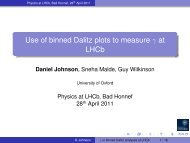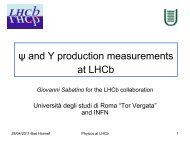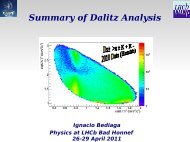Introduction to Dalitz Plot Analysis - University of Warwick
Introduction to Dalitz Plot Analysis - University of Warwick
Introduction to Dalitz Plot Analysis - University of Warwick
You also want an ePaper? Increase the reach of your titles
YUMPU automatically turns print PDFs into web optimized ePapers that Google loves.
<strong>Introduction</strong> <strong>to</strong> <strong>Dalitz</strong> <strong>Plot</strong> <strong>Analysis</strong>Tim Gershon<strong>University</strong> <strong>of</strong> <strong>Warwick</strong>479.WE-Heraeus-SeminarPhysics at LHCb26 April 2011Tim Gershon<strong>Introduction</strong> <strong>to</strong> <strong>Dalitz</strong> <strong>Plot</strong> <strong>Analysis</strong>
What Is a <strong>Dalitz</strong> <strong>Plot</strong>?●Visual representation <strong>of</strong>●the phase-space <strong>of</strong> a three-body decay– involving only spin-0 particles– (term <strong>of</strong>ten abused <strong>to</strong> refer <strong>to</strong> phase-space <strong>of</strong> any multibody decay)●Named after it's inven<strong>to</strong>r, Richard <strong>Dalitz</strong> (1925–2006):●“On the analysis <strong>of</strong> tau-meson data and the nature <strong>of</strong> the tau-meson.”– R.H. <strong>Dalitz</strong>, Phil. Mag. 44 (1953) 1068– (his<strong>to</strong>rical reminder: tau meson = charged kaon)●For scientific obituary, see– I.J.R. Aitchison, F.E. Close, A. Gal, D.J. Millener,– Nucl.Phys.A771:8-25,2006Tim Gershon<strong>Introduction</strong> <strong>to</strong> <strong>Dalitz</strong> <strong>Plot</strong> <strong>Analysis</strong>Image credit: Mike Penning<strong>to</strong>n
“Equilateral representation”scattering regionsAtCConnection between scattering anddecay processes provides a solidtheoretical ground for describing somehadronic effects – “Watson's theorem”BDMandelstam variablesABuDCACDsABCDTim Gershon<strong>Introduction</strong> <strong>to</strong> <strong>Dalitz</strong> <strong>Plot</strong> <strong>Analysis</strong>BImage credit: Mike Penning<strong>to</strong>n3
In case anyone is wondering ...● Previous plot shows pp→π–0 π 0 π 0 fromCrystal Barrel experiment (LEAR)●C.Amsler et al., EPJC 23 (2002) 29●Highly symmetrized because 3 identicalbosons in the final state●symmetric under interchange <strong>of</strong> any 2 π 0Tim Gershon<strong>Introduction</strong> <strong>to</strong> <strong>Dalitz</strong> <strong>Plot</strong> <strong>Analysis</strong>4
“Right-angled representation”Removes some <strong>of</strong> the symmetry … but easier for most s<strong>of</strong>tware <strong>to</strong> handle(Most decays that we are interested in are not so symmetric anyway)Retains & heightens intuitive connection between visualisation and kinematics0 → 1 2 3M m 1m 2m 3Lorentz invariant phase-space<strong>of</strong> three-body decaydΩ ~ ds 12ds 13Tim Gershon<strong>Introduction</strong> <strong>to</strong> <strong>Dalitz</strong> <strong>Plot</strong> <strong>Analysis</strong>5
<strong>Dalitz</strong> plots as visualiser <strong>of</strong> kinematics● Illustration for D→K Sπ + π –●●●●green & blue: K*(892) (vec<strong>to</strong>r)cyan & magenta : K 2*(1430) (tensor)yellow : ρ(770) (vec<strong>to</strong>r)red : f 0(980) (scalar)●but main advantage <strong>of</strong> <strong>Dalitz</strong> plots is ability <strong>to</strong>exploit inference between different resonancesImage credit: Tom LathamTim Gershon<strong>Introduction</strong> <strong>to</strong> <strong>Dalitz</strong> <strong>Plot</strong> <strong>Analysis</strong>6
Some examples <strong>of</strong> <strong>Dalitz</strong> plotsD 0 → K sπ + π –BaBar PRL 105 (2010) 081803D s + → π + π – π +BaBar PRD 79 (2009) 032003K*,interferencef 0Tim Gershon<strong>Introduction</strong> <strong>to</strong> <strong>Dalitz</strong> <strong>Plot</strong> <strong>Analysis</strong>Note symmetries7
Some examples <strong>of</strong> <strong>Dalitz</strong> plotsB + → D – π + π +Belle PRD 69 (2004) 112002B + → K + K + K –Belle PRD 71 (2005) 092003D 2* Φ,nonresonantTim Gershon<strong>Introduction</strong> <strong>to</strong> <strong>Dalitz</strong> <strong>Plot</strong> <strong>Analysis</strong>Note symmetries8
Why are we so interested in <strong>Dalitz</strong> plots?●●●–Condition for DCPV: |A/A|≠1– Need A and A <strong>to</strong> consist <strong>of</strong> (at least) two parts– with different weak (φ) and strong (δ) phasesOften realised by “tree” and “penguin” diagramsA = ∣T∣e i T − T i∣P∣e P − P A = ∣T∣e i T T i∣P∣e P P A CP = ∣A∣2 −∣A∣ 2∣A∣ 2 ∣A∣ 2 =2 ∣T∣∣P∣sin T− P sin T− P∣T∣ 2 ∣P∣ 2 2 ∣T∣∣P∣cos T− Pcos T− PExample: B→Kπ(weak phase difference is γ)Tim Gershon<strong>Introduction</strong> <strong>to</strong> <strong>Dalitz</strong> <strong>Plot</strong> <strong>Analysis</strong>9
Why are we so interested in <strong>Dalitz</strong> plots?●●●–Condition for DCPV: |A/A|≠1Need A– and A <strong>to</strong> consist <strong>of</strong> (at least) two partsProblem with two-body decays:– with different weak (φ) and strong (δ) phases● 2 observables (B, A CP)Often realised by “tree” and “penguin” diagrams● 4 unknowns (|T|, |P|, δ T– δ P, φ T– φ P)A = ∣T∣e i T − T i∣P∣e P − P A = ∣T∣e i T T i∣P∣e P P 2 ∣T∣∣P∣sin T− P sin T− PA CP = ∣A∣2 −∣A∣ 2∣A∣ 2 ∣A∣ 2 =∣T∣ 2 ∣P∣ 2 2 ∣T∣∣P∣cos T− Pcos T− PExample: B→Kπ(weak phase difference is γ)Tim Gershon<strong>Introduction</strong> <strong>to</strong> <strong>Dalitz</strong> <strong>Plot</strong> <strong>Analysis</strong>10
Direct CP violation in B→Kπ● Direct CP violation in B→Kπ sensitive <strong>to</strong> γ<strong>to</strong>o many hadronic parameters ⇒ need theory inputNB. interesting deviation from naïve expectation“Kπ puzzle”A CP K − =−9.8 1.2 −1.1% A CP K − 0 =5.0±2.5%A CP=−14.8±2.8%HFAG averagesBABAR PRD 76 (2007) 091102 & arXiv:0807.4226; also CDFand now LHCb!(results not in average yet)Could be a sign <strong>of</strong> new physics …… but need <strong>to</strong> rule out possibility <strong>of</strong> largerthan expected QCD correctionsBelle Nature 452 (2008) 332Tim Gershon<strong>Introduction</strong> <strong>to</strong> <strong>Dalitz</strong> <strong>Plot</strong> <strong>Analysis</strong>11
<strong>Dalitz</strong> plot analysis●●●Amplitude analysis <strong>to</strong> extract directly information related<strong>to</strong> the phase at each <strong>Dalitz</strong> plot positionMost commonly performed in the “isobar model”●●●sum <strong>of</strong> interfering resonanceseach described by Breit-Wigner (or similar) lineshapes,spin terms, etc.fit can be unbinned, but has inherent model dependenceAlternative approaches aiming <strong>to</strong> avoid modeldependence usually involve binning●partial wave analysisTim Gershon<strong>Introduction</strong> <strong>to</strong> <strong>Dalitz</strong> <strong>Plot</strong> <strong>Analysis</strong>12
Pros and cons <strong>of</strong> <strong>Dalitz</strong> plots●●Pros●●●Cons●More observables (B & A CPat each <strong>Dalitz</strong> plot point)Using isobar formalism, can express <strong>to</strong>tal amplitude as coherent sum <strong>of</strong>quasi-two-body contributionsAm 122 ,m 232 =∑ rc rF rm 12– where c r& F rcontain the weak and strong physics, respectively– n.b. each c ris itself a sum <strong>of</strong> contributions from tree, penguin, etc.Interference provides additional sensitivity <strong>to</strong> CP violationNeed <strong>to</strong> understand hadronic (F r) fac<strong>to</strong>rs2 ,m 2 23●– lineshapes, angular terms, barrier fac<strong>to</strong>rs, ...Isobar formalism only an approximation● Model dependenceTim Gershon<strong>Introduction</strong> <strong>to</strong> <strong>Dalitz</strong> <strong>Plot</strong> <strong>Analysis</strong>13
Model includes:● K ∗ 0 (892)π+, K *0 2(1430)π +●(Kπ) 0 ∗ π + (LASS lineshape)B + →K + π + π – BaBar PRD 78 (2008) 012004See also Belle PRL 96 (2006) 251803● ρ 0 (770)K + , ω(782)K + , f 0(980)K + , f 2(1270)K + , χ c0K +●f X(1300)K + , phase-space nonresonantTim Gershon<strong>Introduction</strong> <strong>to</strong> <strong>Dalitz</strong> <strong>Plot</strong> <strong>Analysis</strong>14
Model includes:● K ∗ 0 (892)π+, K *0 2(1430)π +●(Kπ) 0 ∗ π + (LASS lineshape)B + →K + π + π – BaBar PRD 78 (2008) 012004See also Belle PRL 96 (2006) 251803● ρ 0 (770)K + , ω(782)K + , f 0(980)K + , f 2(1270)K + , χ c0K +●f X(1300)K + , phase-space nonresonantTim Gershon<strong>Introduction</strong> <strong>to</strong> <strong>Dalitz</strong> <strong>Plot</strong> <strong>Analysis</strong>Evidence for direct CP violationBut significant model dependence15
B + →K + π + π – BaBar PRD 78 (2008) 012004Evidence for direct CP violationModel includes:But significant model dependence● K ∗ 0 (892)π+, K *0 2(1430)π +● (Kπ) ∗ 0π + Huge potential for LHCb ...(LASS lineshape)… but need <strong>to</strong> reduce model dependence● ρ 0 (770)K + , ω(782)K + , f 0(980)K + , f 2(1270)K + , χ c0K +●f X(1300)K + , phase-space nonresonantTim GershonNabis-related stuffSee also Belle PRL 96 (2006) 25180316
Sources <strong>of</strong> model dependence●●●Lineshapes●coupled channels, threshold effects, etc.Isobar formalism●●“sum <strong>of</strong> Breit-Wigners” model violates unitarityproblem most severe for broad, overlapping resonances– even talking about “mass” and “width” for such states is not strictlycorrect (process dependent) – can only be defined by pole positionNonresonant contributions●●such terms are small for D decays, but are found <strong>to</strong> be large forsome B decays (not well unders<strong>to</strong>od why)interference with other (S-wave) terms can lead <strong>to</strong> unphysicalphase variationsTim Gershon<strong>Introduction</strong> <strong>to</strong> <strong>Dalitz</strong> <strong>Plot</strong> <strong>Analysis</strong>17
Are methods used for D decay<strong>Dalitz</strong> plots also valid for B decays?D→K – π + π 0 B→K – π + π 0Same modelas D decayTim Gershon<strong>Introduction</strong> <strong>to</strong> <strong>Dalitz</strong> <strong>Plot</strong> <strong>Analysis</strong>Image credit: Brian MeadowsD <strong>Dalitz</strong> plo<strong>to</strong>n same scale18
How <strong>to</strong> address modeldependence?●●Model independent methods●●●<strong>Dalitz</strong> plot anisotropy (“Miranda” method)binned D <strong>Dalitz</strong> plots for measurement <strong>of</strong> γ in B→DK (andcharm mixing & CP violation)partial wave analysisMore robust (but still model dependent) methods●●●K-matrix approachuse <strong>of</strong> scattering data <strong>to</strong> constrain phase variation (Watson'stheorem) – e.g. LASS shape for (Kπ) S-waveinput from theory (chiral symmetry, dispersion relations)Tim Gershon<strong>Introduction</strong> Nabis-related <strong>to</strong> <strong>Dalitz</strong> <strong>Plot</strong> stuff <strong>Analysis</strong>More details in talks <strong>of</strong> Chris<strong>to</strong>ph Hanhart andLeonard Lesniak in parallel session on Thursday19
“Miranda” procedurea.k.a. <strong>Dalitz</strong> plot anisotropyPRD 80 (2009) 096006Toy model (using B + →K + π + π – )Without CP violation With CP violationGaussianNot Gaussian●●●Good model-independent way <strong>to</strong> identify CP violation● could be sufficient <strong>to</strong> identify non-SM physics in, e.g., charm decaysConstant (DP independent) systematic asymmetries can be accounted forCan isolate region <strong>of</strong> the <strong>Dalitz</strong> plot where CP violation effects occurTim Gershon<strong>Introduction</strong> <strong>to</strong> <strong>Dalitz</strong> <strong>Plot</strong> <strong>Analysis</strong>But does not provide quantitative measure <strong>of</strong> weak phase20
Example partial wave analysis:D s+→K + K – π + (BaBar)<strong>Plot</strong> m(K + K - ),, weighting events by fac<strong>to</strong>rsY L0(cos θ ΚΚ )/ε <strong>to</strong> obtain “moments“”φ(1020)~101K Events96% purityK* 0 (892) π +D s+θ KKTim Gershon<strong>Introduction</strong> <strong>to</strong> <strong>Dalitz</strong> <strong>Plot</strong> <strong>Analysis</strong>21
Example partial wave analysis:D s + →K + K – π + (BaBar)(Approximately) model-independent informationon the KK S-wave magnitude and phaseAmbiguity in φ SPresolvedby knowledge <strong>of</strong> φ(1020)phase variationSeems processindependent?From K + K -cross channelTim Gershon<strong>Introduction</strong> <strong>to</strong> <strong>Dalitz</strong> <strong>Plot</strong> <strong>Analysis</strong>22
Quasi-model-independent partialwave analysis● Pioneered by E791 (B.Meadows) in D + →K – π + π +●Describe S-wave by complex spline (many freeparameters)● Example: D s + →π – π + π + from BaBarMagnitudePhase (radians)f 0(980)Symmetrized <strong>Dalitz</strong> plot13K eventsf 0(980)f 0(980)Tim Gershon<strong>Introduction</strong> <strong>to</strong> <strong>Dalitz</strong> <strong>Plot</strong> <strong>Analysis</strong>23
ππ S-wave comparisonData points from BaBarTim Gershon<strong>Introduction</strong> <strong>to</strong> <strong>Dalitz</strong> <strong>Plot</strong> <strong>Analysis</strong>24
ππ S-wave comparisonData points from BaBarTim Gershon<strong>Introduction</strong> <strong>to</strong> <strong>Dalitz</strong> <strong>Plot</strong> <strong>Analysis</strong>Prediction from theory:Kaminski et al. PRD77:054015,200825
Extracting weak phases from <strong>Dalitz</strong> plots●Many methods exist in the literature●some have been used by the B fac<strong>to</strong>ries●●– most results are statistically limited– in some cases model uncertainties are an issuestill plenty <strong>of</strong> room for good new ideasExamples (there are many more!)● Snyder-Quinn method <strong>to</strong> measure α from B → π + π – π 0● GGSZ/BP method <strong>to</strong> measure γ from B ± → DK ± with D → K Sπ + π –● Measurement <strong>of</strong> charm oscillation parameters using D → K Sπ + π –●Various methods <strong>to</strong> measure γ from three-body charmless B decays(B {u,d,s}→ πππ, Kππ, KKπ, KKK)●Penguin-free measurements <strong>of</strong> β & β sfrom Dπ + π – & DK + K – , respectivelyTim Gershon<strong>Introduction</strong> <strong>to</strong> <strong>Dalitz</strong> <strong>Plot</strong> <strong>Analysis</strong>26
B→π + π – π 0 – B fac<strong>to</strong>ry results●Results from●Belle, 449 M BB pairs: PRL 98 (2007) 221602, PRD 77 (2008) 072001●BaBar, 375 M BB pairs: PRD 76 (2007) 012004Tim GershonWeak <strong>Introduction</strong> Phases <strong>to</strong> <strong>Dalitz</strong> from <strong>Plot</strong> <strong>Dalitz</strong> <strong>Analysis</strong> <strong>Plot</strong>s ρ + π – ρ – π + ρ 0 π 027
B→π + π – π 0 – B fac<strong>to</strong>ry results●Results from●Belle, 449 M BB pairs: PRL 98 (2007) 221602, PRD 77 (2008) 072001●BaBar, 375 M BB pairs: PRD 76 (2007) 012004Con<strong>to</strong>ur from B→π + π – π 0 onlyTim GershonWeak <strong>Introduction</strong> Phases <strong>to</strong> <strong>Dalitz</strong> from <strong>Plot</strong> <strong>Dalitz</strong> <strong>Analysis</strong><strong>Plot</strong>sIncluding also information onB + →ρ + π 0 and B + →ρ 0 π +28
B ± → DK ± with D → K Sπ + π –Interference between b → u and b → c amplitudes when D is reconstructed–in final state common <strong>to</strong> D 0 and D 0 provides sensitivity <strong>to</strong> γModel (f D(m + 2 , m – 2 )) taken from measurements <strong>of</strong> |f D| 2 using flavourtagging D* decays – model dependencePRL 105 (2010) 121801 PRD 81 (2010) 112002Tim GershonWeak <strong>Introduction</strong> Phases <strong>to</strong> <strong>Dalitz</strong> from <strong>Plot</strong> <strong>Dalitz</strong> <strong>Analysis</strong><strong>Plot</strong>s29
B ± → DK ± with D → K Sπ + π ––Solution – bin the <strong>Dalitz</strong> plot and use ψ(3770) → DD events (CLEOc,BES) <strong>to</strong> measure per-bin phasesPRD 68, 054018 (2003), EPJ C 47, 347 (2006); EPJ C 55, 51 (2008)(unusual bin shapes <strong>to</strong> attempt <strong>to</strong> optimise sensitivity)c i, s imeasured by CLEOPRD 82, 112006 (2010)Tim GershonWeak <strong>Introduction</strong> Phases <strong>to</strong> <strong>Dalitz</strong> from <strong>Plot</strong> <strong>Dalitz</strong> <strong>Analysis</strong><strong>Plot</strong>sFirst model independent measuremen<strong>to</strong>f γ in this mode by Belle30
Looking ahead●●I hope I have already convinced you that there is greatphysics potential in <strong>Dalitz</strong> plot analysisBut there are also considerable challenges●●theoretical (hadronic effects, etc.)experimental– <strong>Dalitz</strong> plot dependent effects:– Efficiency– Background– Mass resolution– Misreconstruction effects …● I leave the details <strong>to</strong> the parallel session speakers, but ...Tim GershonWeak <strong>Introduction</strong> Phases <strong>to</strong> <strong>Dalitz</strong> from <strong>Plot</strong> <strong>Dalitz</strong> <strong>Analysis</strong><strong>Plot</strong>s31
Motivation for “Les Nabis”●From I. Bigi, “Hadronization — the Unsung Hero rather than the alleged Villainin the Tale <strong>of</strong> CP Violation”, proceedings <strong>of</strong> Hadron '05●“We expect confidently that New Physics surfaces at the TeV scale. Yet wehave <strong>to</strong> aim beyond ‘merely’ establishing the existence <strong>of</strong> New Physics – ourgoal has <strong>to</strong> be <strong>to</strong> identify its salient features. The discovery potential in Bdecays is essential, not a luxury. Yet due <strong>to</strong> the past ‘unlikely’ success <strong>of</strong> theCKM description one cannot count on massive manifestations <strong>of</strong> New Physics.Therefore we need high accuracy both on the experimental and theoretical sidein heavy flavour studies. This requires a better quantitative understanding <strong>of</strong>hadronization <strong>to</strong> exhaust the discovery potential in B decays.”●“The expertise required <strong>to</strong> attain an essential goal – namely <strong>to</strong> exhaust thediscovery potential in heavy flavour transitions by harnessing low-energyhadronization – does exist or can be acquired with no need for a breakthrough.However it tends <strong>to</strong> reside in a community all <strong>to</strong>o <strong>of</strong>ten disjoint from the heavyflavour community – this has <strong>to</strong> change!”Tim Gershon<strong>Introduction</strong> <strong>to</strong> <strong>Dalitz</strong> <strong>Plot</strong> <strong>Analysis</strong>32
Erm, What is “Les Nabis”?●●●●A group <strong>of</strong> experimentalists and theorists, drawn from bothparticle/heavy flavour and nuclear/hadronic physicscommunities, set up <strong>to</strong> address issues in <strong>Dalitz</strong> plotanalysis with the aim <strong>of</strong> obtaining both qualitative andquantitative information on weak phases and CP violationTheory:●I. Bigi, S. Gardner, C. Hanhart, B. Kubis, T. Mannel, U.-G.Meißner, J. Pelaez, M. Penning<strong>to</strong>nExperiment:●I. Bediaga, A. Bondar, A. Denig, T. Gershon, W. Gradl, B.Meadows, K. Peters, U. Wiedner, G. Wilkinson(This is the list on the Nabis web page – apologies for any omissions)Tim Gershon<strong>Introduction</strong> <strong>to</strong> <strong>Dalitz</strong> <strong>Plot</strong> <strong>Analysis</strong>33
OK, but why is it called “Les Nabis”?●From the manifes<strong>to</strong> (yes, really):●“Les Nabis” means “the Prophets” in Hebrew, and this name had beenadopted by a group <strong>of</strong> post-impressionist artists who set the pace forpaintings and graphics in France in the 1890s. With some <strong>of</strong> usharbouring a similar sense <strong>of</strong> modesty as those artists, we found a reincarnation<strong>of</strong> “Les Nabis” an appropriate mot<strong>to</strong> for our group and itsefforts. This is further strengthened by the fact that one work by a centralmember <strong>of</strong> the original “Les Nabis” seems <strong>to</strong> show a (somewhatartistically enhanced) image <strong>of</strong> a <strong>Dalitz</strong> plot – it is “The Talisman” by PaulSérusier. We have chosen it as our logo.Tim Gershon<strong>Introduction</strong> <strong>to</strong> <strong>Dalitz</strong> <strong>Plot</strong> <strong>Analysis</strong>“The Talisman”, Paul Sérusier34
Summer school●●School on Amplitude <strong>Analysis</strong> in Modern Physics:from hadron spectroscopy <strong>to</strong> CP phasesAugust 1-5, 2011 at Physikzentrum Bad Honnef, Germany●http://www2.fz-juelich.de/ikp/workshops/LesNabis/index.shtmlTim Gershon<strong>Introduction</strong> <strong>to</strong> <strong>Dalitz</strong> <strong>Plot</strong> <strong>Analysis</strong>35
Summary●●●●●<strong>Dalitz</strong> plot analyses provide promising methods <strong>to</strong>measure weak phases and CP violationMany attractive features …… but significant complications due <strong>to</strong> modeldependenceNeed progress on several fronts– Understand better (ππ), (Kπ), (KK), (Dπ), (DK) systems– “Nonresonant” contributions and 3-body unitarity– Methods <strong>to</strong> combat model-dependence– Nabis initiative set up <strong>to</strong> try <strong>to</strong> address thisMany new possibilities opening up with LHCbTim Gershon<strong>Introduction</strong> <strong>to</strong> <strong>Dalitz</strong> <strong>Plot</strong> <strong>Analysis</strong>36
For more details, please come <strong>to</strong>the parallel sessionThursday 28 April 2011Tim Gershon<strong>Introduction</strong> <strong>to</strong> <strong>Dalitz</strong> <strong>Plot</strong> <strong>Analysis</strong>37







